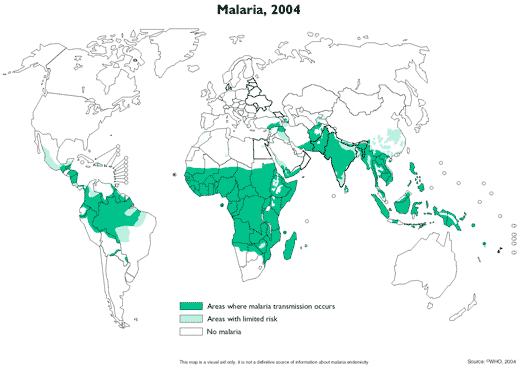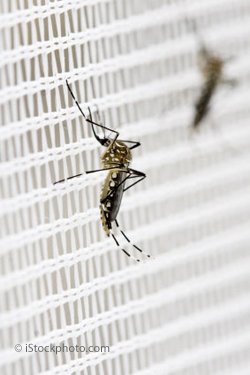Malaria
Malaria is a disease that is spread when a person is bitten by an infected mosquito.
It is most common in Africa but also causes disease in Asia, Central and South America and is the cause of up to 2 million deaths per year. Most of those affected are children under the age of five and pregnant women. In some areas, infant mortality rates of 40% can be due to malaria.
There are fears that with global warming malaria could become even more of a problem and spread back into many parts of Europe.


Map of the world showing the distribution of Malaria in 2004 (Courtesy of the World Health Organisation)
What is malaria?
Malaria is a disease caused by the protozoa Plasmodium, a single-celled parasite that attacks the blood. Mosquitoes act as the vector for the disease. Infected blood is passed from one person to the next by the bite of a mosquito, passing on the disease.
There are 300 million cases of malaria each year and in parts of Africa it is responsible for the deaths of two children every minute. The symptoms of malaria appear about 9 to 14 days after being bitten by an infected mosquito. Fever and vomiting are early signs and if the disease progresses it can cause death due to kidney failure, liver damage or blood clots in the brain.
The malaria parasite first invades liver cells before moving to infect red blood cells which eventually burst. This causes high fevers and shivering. It can be fatal because it causes anaemia and blood clots which block the supply of blood to the vital organs
Mosquitoes and the spread of malaria
The malaria parasite has a complex life cycle. Roll over the diagram to see how the stages are connected and how malaria is spread.
Mosquitos and the spread of malaria
Medicines and malaria
Malaria is an ancient disease which was known during Roman times. From the 17th century, quinine from the powdered bark of a South American tree was used to treat malaria in Europe. The supply of this medicine was obviously limited and in 1934, scientists made a chemical copy of the active molecule. This new medicine was chloroquine. Many others have been synthesised since then but chloroquine has remained a common treatment for malaria. Chloroquine is absorbed into infected red blood cells and kills the malaria parasite before it can cause damage and spread. Some forms of malaria parasite can survive treatment inside liver cells and cause bouts of malarial fever over many years.

Drug resistance
In some areas of the world, the malaria parasite is becoming resistant to chloroquine and other related medicines. In these cases a combined treatment with chloroquine and an antibiotic is successful in treating acute malaria. Resistance to the traditional quinine has not emerged and this medicine is being increasingly used when other treatments have failed.
Prevention
Travellers who go to areas where malaria is a problem are advised to take anti-malarial medicines like chloroquine. Treatment starts before they leave home and continues for several weeks after their return. Preventing mosquito bites is another way to stop infection. Some prevention programmes use insecticides to try to get rid of the mosquito that transmits malaria but this is an almost impossible task. Mosquitos breed in still water and powerful insecticides can contaminate water that is also used by humans.
Most bites happen during the night and sleeping under mosquito nets treated with insecticide has proved to reduce infection by up to 20% in affected areas. Although this form of prevention is effective, the nets are expensive and, because inhabitants of these areas are extremely poor, even this basic precaution is often not affordable. Many charities are working hard to increase the numbers of insecticide treated mosquito nets available in some of the areas of the world mosty affected by malaria.
Simple mosquito nets, such as that shown in the photo opposite, can help reduce deaths from malaria














